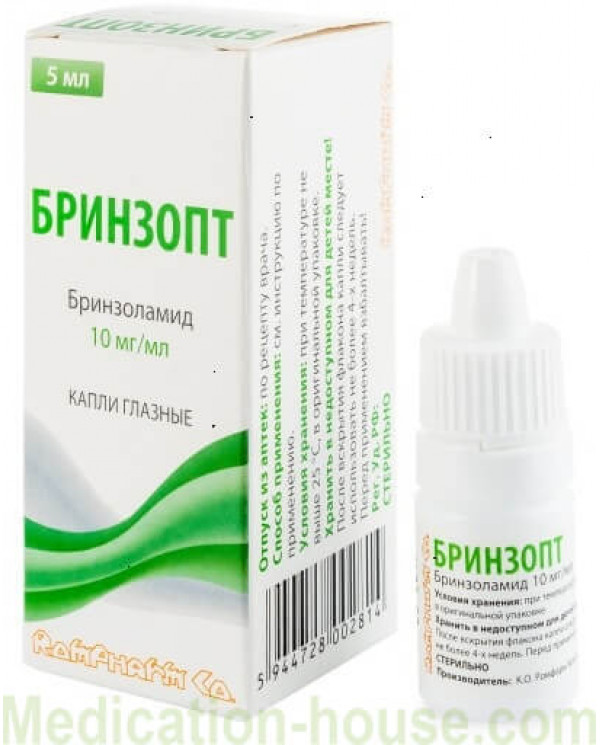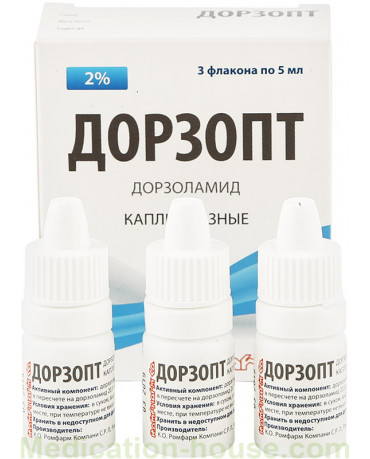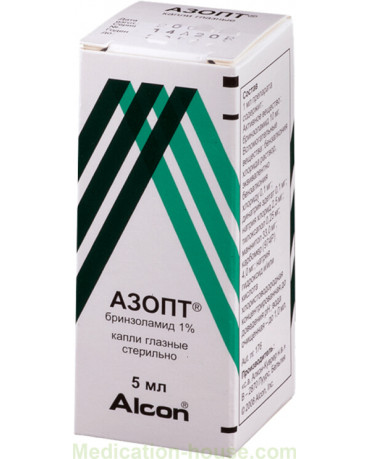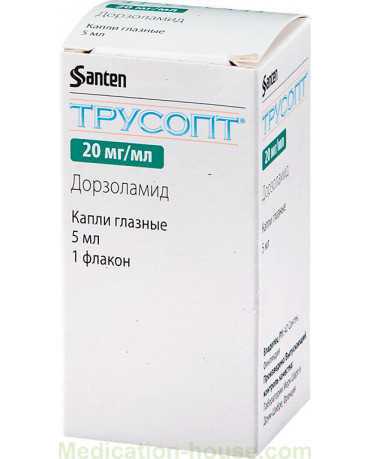Instruction for Brinzopt
To buy Brinzopt just add it to your shopping cart
Release form and composition
Dosage form - eye drops, which are a suspension of almost white or white color (5 ml each in polyethylene bottles with a drop applicator, 1 bottle in a cardboard box for consumer packaging and instructions for use of Brinzopt).
Composition of 1 ml of the preparation:
active substance: brinzolamide - 10 mg;
auxiliary components: benzalkonium chloride, sodium chloride, mannitol (E421), disodium edetate dihydrate, carbomer 974R, tyloxapol, purified water, hydrochloric acid or sodium hydroxide.
Pharmacodynamics
Brinzopt as an active ingredient contains brinzolamide, an inhibitor of carbonic anhydrase II (CA-II), an enzyme that is found in many tissues of the body, including eye tissues.
The drug catalyzes reversible reactions in which hydrolysis of carbonic acid and hydration of carbon dioxide occurs.
Due to inhibition of carbonic anhydrase at the level of the ciliary body, the formation of bicarbonate ions slows down, and subsequently, the transport of sodium and water decreases. This leads to a decrease in the secretion of aqueous humor and, as a consequence, a decrease in intraocular pressure. And increased intraocular pressure, as you know, is the main risk factor for damage to the optic nerve and narrowing of the boundaries of the visual fields.
Pharmacokinetics
After instillation into the conjunctival sac, brinzolamide enters the systemic circulation. It is absorbed in erythrocytes, since it has a high affinity for CA-II. About 60% of the dose is bound to plasma proteins.
The drug is metabolized to form N-desethylbrinzolamide. This metabolite binds to CA (mainly to KA-I in the presence of brinzolamide) and accumulates in erythrocytes. Plasma concentrations of brinzolamide and N-desethylbrinzolamide are below the limit of quantitation (<7.5 ng / ml).
The drug is excreted from whole blood for a long time. The half-life (T½) averages 24 weeks. It is excreted mainly by the kidneys unchanged (about 60%). In urine, both the main metabolite (N-desethylbrinzolamide) and trace amounts of other metabolites (O-desmethyl and N-desmethoxypropyl) are determined.
Indications for use
The drug is used to reduce intraocular pressure in open-angle glaucoma and ophthalmic hypertension in the following cases:
with resistance to beta-blockers;
in the presence of contraindications to the appointment of beta-blockers;
in case of insufficient effect from the use of only beta-blockers or prostaglandin analogues.
Contraindications
Absolute:
hyperchloremic acidosis;
severe renal failure;
age under 17;
pregnancy and lactation;
hypersensitivity to sulfonamides, brinzolamide or any of the auxiliary components of Brinzopt.
In addition, it is not recommended to prescribe drops in liver failure or in the presence of narrow-angle glaucoma, since their use in patients with these diseases has not been studied.
Relative contraindications (care must be taken when using Brinzopt eye drops):
pseudoexfoliative or pigmentary glaucoma;
the presence of predisposing factors for the development of renal failure (metabolic acidosis is possible);
conditions / diseases accompanied by a high risk of corneal damage, such as corneal dystrophy and diabetes mellitus.
Instructions for use: method and dosage
Brinzopt eye drops are instilled into the conjunctival sac. After instillation, it is recommended to carefully close the eyelids (to ensure nasolacrimal occlusion) in order to reduce the ingress of the drug into the systemic circulation and, as a consequence, reduce the risk of developing systemic adverse effects. Shake the bottle well before each use. The bottle should be kept tightly closed between uses. When instilling in order to avoid contamination / contamination of the suspension, extreme care must be taken not to allow the dropper tip to come into contact with the eye and other surfaces.
Brinzopt is usually prescribed 1 drop in each affected eye 2 times a day. In some cases, it is required to increase the frequency of application of the drug up to 3 times a day.
When the drug is prescribed in combination with other ophthalmological agents, the preparations should be installed at intervals of at least 5 minutes, while the eye ointments should be applied last.
When a patient is transferred to Brinzopt from another antiglaucoma drug, treatment can be started from the next day.
If the next dose is missed, a double dose should not be instilled; therapy is continued with the next instillation.
Side effects
In clinical trials, more than 2,732 patients received brinzolamide as a single drug or in combination with the beta-blocker timolol maleate 5 mg / ml. Within a few seconds to a few minutes after instillation, the following adverse reactions were most often observed: dysgeusia (6%) and temporary blurred vision (5.4%).
According to the data of clinical studies and post-registration spontaneous reports, Brinzopt can cause the following side effects (they are classified by the frequency of development in this way: ≥ 1/10 - very often; from ≥ 1/100 to <1/10 - often; from ≥ 1/1000 up to <1/100 - infrequently; from ≥ 1/10 000 to <1/1000 - rarely; <1/10 000 - very rare; unknown frequency - based on available data, the frequency cannot be estimated):
on the part of the organ of vision: often - a sensation of a foreign body and pain in the eyes, eye irritation, blurred vision, ocular hyperemia; infrequently - corneal staining, punctate keratitis, keratitis, keratopathy, itchy eyes, conjunctival edema, allergic conjunctivitis, photophobia, meibomitis, conjunctivitis, accumulations in the eye, blepharitis, discomfort or unusual sensation in the eye, lacrimation, lacrimation, itching , pigmentation of the sclera, discharge from the eyes, subconjunctival cysts, violations of the integrity or defect of the corneal epithelium, pterygium, corneal erosion, crust on the edges of the eyelids, conjunctival injection, accumulation of pigment in the cornea during diagnostic tests to confirm the violation of the integrity of the corneal epithelium; rarely - edema of the periorbital area, change in the ratio of excavation diameters to the diameter of the optic nerve head, decreased visual acuity, diplopia, hypesthesia, photopsia, corneal edema, increased intraocular pressure; unknown frequency - madarosis, erythema of the eyelids, visual impairment, disorders of the cornea and eyelids, allergic manifestations of the eyes;
from the organ of hearing and the labyrinth: rarely - ringing in the ears; unspecified frequency - dizziness;
from the nervous system and psyche: infrequently - headache, motor dysfunction, paresthesia, dizziness, amnesia, nightmares, apathy, nervousness, depression, depressed mood, decreased libido; rarely - drowsiness, insomnia, memory impairment; unknown frequency - ageusia, hypoesthesia, tremor;
from the gastrointestinal tract and nutrition: often - dysgeusia; infrequently - paresthesia in the mouth, dry mouth, decreased sensitivity in the mouth, pain in the upper abdomen, flatulence, discomfort in the stomach or abdomen, nausea, dyspepsia, diarrhea, vomiting, esophagitis, gastrointestinal disorders, frequent bowel movements; unspecified frequency - decreased appetite;
from the hepatobiliary system: unspecified frequency - change in the results of the analysis of the functional state of the liver;
from the immune system: unknown frequency - manifestations of hypersensitivity to the drug;
on the part of the hematopoietic system: infrequently - an increase in the content of chlorine in the plasma, a decrease in the number of red blood cells;
from the urinary tract and kidney function: infrequently - pain in the kidney area; unspecified frequency - pollakiuria;
on the part of the connective tissue and musculoskeletal system: infrequently - muscle spasms, back pain, myalgia; unspecified frequency - pain in the limbs, arthralgia;
from the respiratory system: infrequently - irritation in the throat, oropharyngeal pain, pharyngeal-laryngeal pain, sneezing, runny nose, nosebleeds, shortness of breath, upper respiratory tract cough syndrome; rarely - nasal congestion, dry nose, swelling of the mucous membrane of the paranasal sinuses, a feeling of congestion in the upper respiratory tract, bronchial hyperactivity, cough; unknown frequency - bronchial asthma;
on the part of the cardiovascular system: infrequently - heart palpitations, bradycardia, cardiorespiratory distress syndrome; rarely - heart rhythm disturbance, angina pectoris; unspecified frequency - increase or decrease in blood pressure, hypertension, arrhythmia, increased heart rate, tachycardia;
on the part of the skin and subcutaneous fat: infrequently - skin rashes (including maculopapular rash), a feeling of tightness of the skin; rarely - generalized itching, urticaria, hair loss; unknown frequency - erythema, dermatitis;
from the reproductive system: infrequently - erectile dysfunction;
infections and infections: infrequently - sinusitis, pharyngitis, nasopharyngitis; unspecified frequency - rhinitis;
others: infrequently - increased fatigue, chest pain or discomfort, unusual sensations; rarely - irritability, anxiety, chest pain, asthenia; unspecified frequency - malaise, peripheral edema.
In a small number of short-term studies of the use of Brinzopt in children, side effects were observed in about 12.5% of cases. Most of these were minor local reactions: eye irritation, conjunctival injection, lacrimation and eye discharge.
Description of selected adverse reactions
According to clinical studies of brinzolamide, the most common systemic side effect is dysgeusia (an unusual or bitter taste in the mouth after instillation of the drug into the conjunctival sac). This disorder is most likely due to the passage of the suspension through the nasolacrimal canal into the nasopharynx. To reduce the severity of this effect, a short closing of the eyelids after instillation helps.
Side effects from the nervous system, gastrointestinal tract, kidney and hematological parameters, as well as metabolic disorders, mainly occur with the use of systemic carbonic anhydrase inhibitors. Brinzopt is a carbonic anhydrase inhibitor with a sulfonamide structure, therefore, when instilled in the eyes, it can also cause similar reactions.
When using brinzolamide in addition to travoprost therapy, no unexpected adverse events were identified. The observed disorders in the combined treatment were comparable to those after the use of each of the drugs separately.
Overdose
There are no reports of cases of overdose of Brinzopt. It is expected that if the recommended dose is significantly exceeded, disorders of the nervous system are possible, acidosis and electrolyte imbalance may develop.
Treatment is symptomatic and supportive. In patients, it is necessary to monitor the level of blood pH and the concentration of electrolytes in plasma.
Special instructions
Despite the local use of the drug, brinzolamide can enter the systemic circulation and cause side effects typical of systemic sulfonamides. In case of development of serious hypersensitivity reactions, Brinzopt treatment is discontinued.
Brinzolamide has been shown to be effective when added to timolol for the treatment of glaucoma. The effect of Brinzopt in reducing intraocular pressure when added to travoprost (a prostaglandin analogue) has also been noted, however, there are no long-term data on the use of brinzolamide as an adjunct therapy to travoprost.
Brinzopt contains benzalkonium chloride as a preservative, which can cause punctate keratopathy and / or toxic ulcerative keratopathy. In this regard, caution should be exercised in patients with corneal injuries and dry eye syndrome.
In patients with damaged cornea (especially in those with a reduced number of endothelial cells), the effect of brinzolamide on the corneal endothelium has not been studied.
Carbonic anhydrase inhibitors can affect the degree of corneal hydration, which increases the risk of corneal injury when wearing contact lenses. Patients are advised to remove lenses before instilling eye drops and put them on at least 15 minutes after applying Brinzopt. Special medical supervision is required for patients with a high risk of corneal damage (with corneal dystrophies and diabetes mellitus).
With the simultaneous use of carbonic anhydrase inhibitors in dosage forms for topical use and oral administration, an additive effect may develop. In this regard, it is not recommended to use Brinzopt in conjunction with oral carbonic anhydrase inhibitors.
Experience in the treatment of pseudoexfoliative and pigmentary glaucoma with brinzolamide is limited. For this reason, precautions should be taken and intraocular pressure controlled.
The effect of the drug in narrow-angle glaucoma has not been studied, its use in this disease is not recommended.
There are known cases of acid-base imbalance in patients taking carbonic anhydrase inhibitors inside. Brinzopt should be used with caution to treat patients who are at risk of developing renal failure, due to the likelihood of metabolic acidosis.
There is no information on withdrawal symptoms after cessation of brinzolamide treatment. It is expected that Brinzopt's effect in reducing intraocular pressure may last up to 5-7 days.
The effect of brinzolamide, applied topically in ophthalmology, on human fertility has not been studied. No adverse effects have been identified in animal studies.
Influence on the ability to drive vehicles and complex mechanisms
When using the drug, a slight effect on a person's ability to drive vehicles and work with complex mechanisms was noted. Oral carbonic anhydrase inhibitors can cause impaired movement coordination and concentration. Since, after instilling drops, the drug enters the systemic circulation, it can also cause undesirable effects.
In some patients, immediately after instillation of Brinzopt, visual impairments (including fogging) are noted. In these cases, it is recommended to refrain from performing potentially hazardous activities for some time after using the drug (until vision is restored).
Application during pregnancy and lactation
There is no reliable data on the safety of using brinzolamide during pregnancy. In the course of studies on animals, it was revealed that the drug used systemically has reproductive toxicity. In this regard, the appointment of Brinzopt is not recommended for pregnant women. During treatment, you should use reliable methods of contraception.
There is no information on the penetration of brinzolamide and / or its metabolites into mother's milk after topical application in ophthalmology. According to animal studies, after oral administration, the drug passes into breast milk in minimal quantities. Given the potential risk of side effects in infants, it is recommended either to stop breastfeeding or to refrain from drug treatment.
Childhood use
The safety and efficacy of Brinzopt in children under 17 years of age have not been established, therefore, the administration of the drug is not recommended for patients of this age category.
With impaired renal function
The effects of Brinzopt in patients with severe renal impairment (creatinine clearance <30 ml / min) and in patients with hyperchloremic acidosis have not been studied. However, it has been established that brinzolamide and its main metabolite are excreted mainly by the kidneys, which is why the use of the drug in these pathologies is contraindicated.
For violations of liver function
Changes in the pharmacokinetics of brinzolamide in liver failure have not been studied, therefore, the appointment of Brinzopt eye drops is not recommended.
Use in the elderly
Brinzopt is used to treat elderly patients. There is no need to adjust the therapeutic regimen.
Drug interactions
Special studies on the interaction of Brinzopt with other medications have not been conducted.
In clinical studies, brinzolamide has been used in conjunction with ophthalmic agents such as timolol and prostaglandin analogues. No adverse reactions were noted.
Brinzolamide is metabolized with the participation of cytochrome P450 isoenzymes: mainly CYP3A4, to a lesser extent - CYP2C9, CYP2A6 and CYP2C8. CYP3A4 inhibitors (itraconazole, ritonavir, ketoconazole, troleandomycin, clotrimazole) are expected to inhibit the metabolism of brinzolamide. In this regard, if necessary, the simultaneous use of these drugs, caution should be exercised. In this case, the cumulation of brinzolamide is unlikely, since it is excreted by the kidneys.
The possibility of the simultaneous use of brinzolamide with adrenergic drugs and miotics has not been studied.
Brinzolamide is not an inhibitor of cytochrome P450 isoenzymes.
Terms and conditions of storage
Store in original packaging at a temperature not exceeding 25 ° C. Keep out of the reach of children.
Shelf life is 2 years. You can store the drug after the first opening of the bottle for no more than 4 weeks.
Reviews
In reviews of the drug, patients predominantly indicate that this drug weakly reduces increased intraocular pressure. Additional disadvantages include the need to store drops in the refrigerator. Some complain that it is difficult to instill the drug in cold form, because the bottle “freezes”. They also indicate the worst tolerance of Brinzopt than other imported analogues.
Terms of sell
You don't need a prescription to buy Brinzopt.




